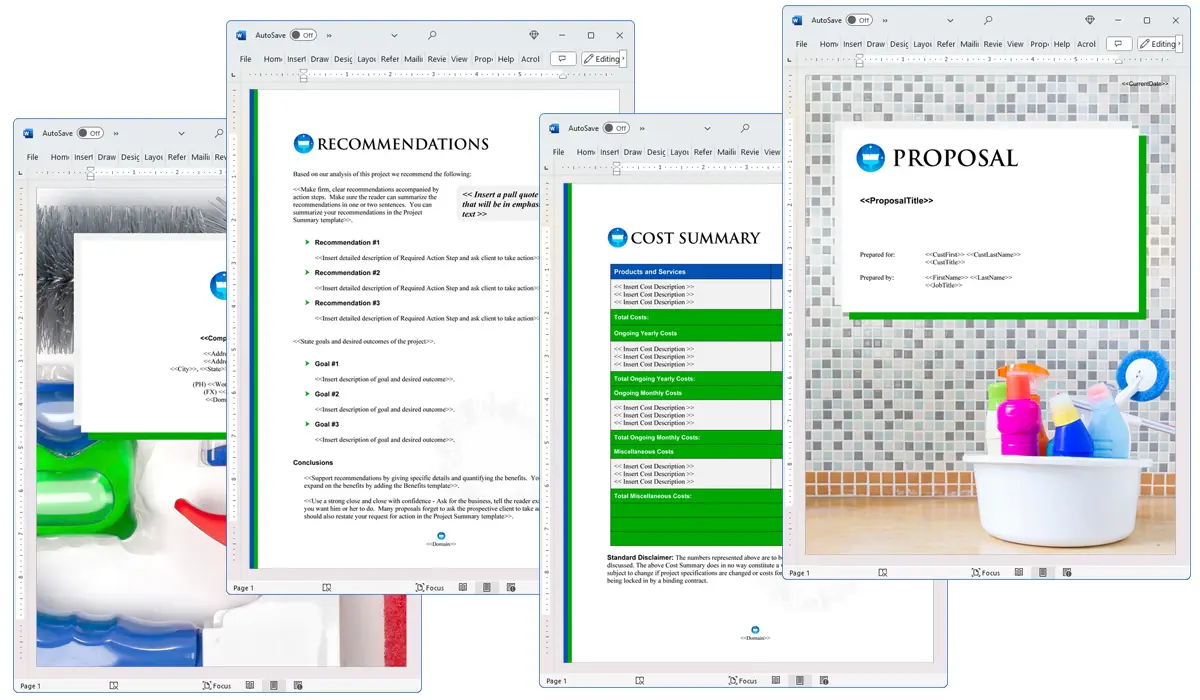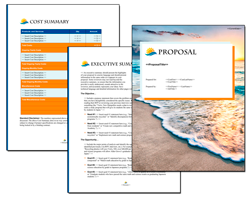What is the Demand Planning chapter used for?
Proposal Kit Professional Bundle adds more design themes, all six Contract Packs,
a project management library, and Expert Edition software.

Illustration of Proposal Pack Janitorial #4
We include this Demand Planning chapter template in every Proposal Pack, along with thousands more. You assemble this chapter with others in various combinations to create custom-tailored business proposals, plans, reports, and other documents. Proposal Packs apply custom visual designs to the templates, giving the final documents a consistent professional finish.
 DOWNLOADABLE, ONE-TIME COST, NO SUBSCRIPTION FEES
DOWNLOADABLE, ONE-TIME COST, NO SUBSCRIPTION FEES
Overview of the Demand Planning Chapter
The Demand Planning chapter is a part of a business proposal, especially when an organization is looking to establish or refine its processes for predicting and meeting customer demand for its products or services. Effective demand planning is crucial for ensuring that a business can adequately supply its products in response to market needs without overproducing or underproducing. This chapter offers a structured approach to demonstrating how your proposals can improve or implement successful demand planning strategies.
How is the Demand Planning Chapter Used?
In a business proposal, the Demand Planning chapter is used to outline the proposer's methodologies and strategies for forecasting product demand and aligning this with production or service supply. This section of the proposal explains the current systems in place (if any), identifies the gaps, and suggests tailored solutions to enhance demand forecasting and fulfillment processes. It's particularly useful in demonstrating to potential clients or stakeholders how their business can be optimized to balance supply with consumer demand efficiently.
What is Included in the Demand Planning Chapter?
Typically, the Demand Planning chapter includes:
- An analysis of the current demand planning systems used by the organization, highlighting both strengths and weaknesses.
- A detailed forecast of future demand using historical data and market analysis.
- Strategies for improving data collection and analysis to enhance the accuracy of demand forecasting.
- Proposed methods for aligning production or service provision schedules with anticipated demand levels.
- Metrics and KPIs for measuring the effectiveness of the implemented demand planning strategies.
This comprehensive approach ensures that all aspects of demand planning are covered, providing a clear and actionable plan for the reader.
Use Case Examples for the Demand Planning Chapter
The Demand Planning chapter can be applied in various contexts within business proposals, including:
- Automation: Proposing systems that automate data collection and analysis to forecast demand more accurately.
- Manufacturing: Planning production schedules to meet forecasted demand without surplus.
- Fabrication: Customizing fabrication processes based on detailed demand forecasts to reduce waste and increase efficiency.
- Supply Chain: Streamlining supply chain operations to ensure timely delivery of goods as per predicted demand.
- Logistics: Optimizing logistics operations to handle expected shipment volumes efficiently.
- Transportation: Adjusting transportation schedules and routes based on demand forecasts to maximize resource use.
- Actions: Specific actions proposed to address demand planning challenges identified during the assessment phase.
These examples show how the Demand Planning chapter can be tailored to address specific needs across various industries and sectors.
Key Takeaways
- The Demand Planning chapter is important for proposals focusing on optimizing supply to meet predicted demand.
- It provides a structured approach to evaluating and proposing improvements in demand forecasting and supply alignment.
- This chapter is and can be adapted for use in industries ranging from manufacturing to logistics.
- Including detailed analyses and actionable strategies in the chapter enhances the proposal's credibility and effectiveness.
- Effective demand planning helps businesses reduce waste, increase efficiency, and improve customer satisfaction.
By integrating the Demand Planning chapter into your business proposals, you can significantly enhance the appeal and persuasive power of your document, clearly showing potential clients or stakeholders how they can achieve optimal balance between demand and supply.

Illustration of Proposal Pack Nature #7
 What Our Clients Say
What Our Clients SayI want to give you an interim report on my download and set up to do a couple of proposals. The system and the improved way you have arranged the Wizard is simply fabulous! I am impressed and excited about my first two proposals I did and sent to clients. The platform is intuitive and user friendly. While I may have a couple of minor questions later on, for now I am set. I am going to refer a couple of my associates directly to you later this month."
 4.7 stars, based on 845 reviews
4.7 stars, based on 845 reviewsRelated Chapters

The Demand Planning chapter and other chapters are integrated into a Word document as illustrated here in the Proposal Pack Networks #5 design theme. There are hundreds of design themes available, and every design theme includes the Demand Planning chapter template.
A proper business proposal will include multiple chapters. This chapter is just one of many you can build into your proposal. We include the complete fill-in-the-blank template in our Proposal Pack template collections. We also include a library of sample proposals illustrating how companies in different industries, both large and small, have written proposals using our Proposal Packs. This template will show you how to write the Demand Planning.
We include a chapter library for you to build from based on your needs. All proposals are different and have different needs and goals. Pick the chapters from our collection and organize them as needed for your proposal.
Using the Proposal Pack template library, you can create any business proposal, report, study, plan, or document.
 Ian Lauder has been helping businesses write their proposals and contracts for two decades. Ian is the owner and founder of Proposal Kit, one of the original sources of business proposal and contract software products started in 1997.
Ian Lauder has been helping businesses write their proposals and contracts for two decades. Ian is the owner and founder of Proposal Kit, one of the original sources of business proposal and contract software products started in 1997.By Ian Lauder
 Published by Proposal Kit, Inc.
Published by Proposal Kit, Inc.


 Cart
Cart
 Facebook
Facebook YouTube
YouTube X
X Search Site
Search Site